Exploring the Spatio-Temporal Dynamics of Winter Rape on the Middle Reaches of Yangtze River Valley Using Time-Series MODIS Data
Abstract
1. Introduction
2. Materials and Methods
2.1. Study Area
2.2. Data
2.3. Extraction of Rapeseed Distribution
2.4. Spatio-Temporal Patterns of Winter Rape Cultivation
3. Results and Analysis
3.1. Validation of Classification Accuracy
3.2. Temporal Changes in Rapeseed Cultivation
3.3. Spatial Fragmentation of Rapeseed Cultivation
4. Discussion
5. Conclusions
Author Contributions
Funding
Acknowledgments
Conflicts of Interest
References
- USDA. Oilseeds: World Markets and Trade. Available online: https://www.fas.usda.gov/data/oilseeds-world-markets-and-trade (accessed on 21 July 2018).
- NBS. National Bureau of Statistics of China. China Stat. Yearb. 2016. Available online: http://www.stats.gov.cn/ (accessed on 21 July 2018).
- Zhang, L.; Liu, T. Study on international competitiveness of soybean industry of China. Agric. Econ. 2015, 3, 116–118. [Google Scholar]
- Wang, J.; Zhu, X. Situation and policy of soybean industry development in China. Issues Agric. Econ. 2000, 9, 39–44. [Google Scholar]
- Ni, H.; Wang, Z.; Liu, W. Development of soybean industry in China under global market. Issues Agric. Econ. 2012, 33, 7–12. [Google Scholar]
- USDA. China: Oilseeds and Products Annual. Available online: https://www.fas.usda.gov/data/china-oilseeds-and-products-annual-2 (accessed on 21 July 2018).
- Khairina, A.K.; Nazlin, I.; Balu, N. Competitiveness of the Rapeseed Industry in China. Oil Palm Ind. Econ. J. 2017, 17, 8–24. [Google Scholar]
- Zhang, Z.; Liu, Z. China’s soybean demand and supply: Current situation and projection for the next 10 years. Soybean Sci. Technol. 2009, 4, 16–21. [Google Scholar]
- Sun, J.; Wu, W.; Tang, H.; Liu, J. Spatiotemporal patterns of non-genetically modified crops in the era of expansion of genetically modified food. Sci. Rep. 2015, 5, 14180. [Google Scholar] [CrossRef]
- Hairong, Y.; Yiyuan, C.; Bun, K.H. China’s soybean crisis: The logic of modernization and its discontents. J. Peasant Stud. 2016, 43, 373–395. [Google Scholar] [CrossRef]
- Sun, J.; Mooney, H.; Wu, W.; Tang, H.; Tong, Y.; Xu, Z.; Huang, B.; Cheng, Y.; Yang, X.; Wei, D. Importing food damages domestic environment: Evidence from global soybean trade. Proc. Natl. Acad. Sci. USA 2018, 115, 5415–5419. [Google Scholar] [CrossRef]
- Jikun, H.; Scott, R.; Min, C. The World Bank Economic Review; World Bank: Washington, DC, USA, 2004; pp. 59–84. [Google Scholar]
- She, B.; Huang, J.; Shi, J.; Wei, C. Extracting oilseed rape growing regions based on variation characteristics of red edge position. Trans. Chin. Soc. Agric. Eng. 2013, 29, 145–152. [Google Scholar]
- Rembold, F.; Meroni, M.; Urbano, F.; Csak, G.; Kerdiles, H.; Perez-Hoyos, A.; Lemoine, G.; Leo, O.; Negre, T. ASAP: A new global early warning system to detect anomaly hot spots of agricultural production for food security analysis. Agric. Syst. 2019, 168, 247–257. [Google Scholar] [CrossRef]
- Xiao, X.; Boles, S.; Liu, J.; Zhuang, D. Mapping paddy rice agriculture in southern China using multi-temporal MODIS images. Remote Sens. Environ. 2005, 95, 480–492. [Google Scholar] [CrossRef]
- Pan, Y.; Li, L.; Zhang, J.; Liang, S.; Zhu, X.; Sulla-Menashe, D. Winter wheat area estimation from MODIS-EVI time series data using the Crop Proportion Phenology Index. Remote Sens. Environ. 2012, 119, 232–242. [Google Scholar] [CrossRef]
- Hu, Q.; Ma, Y.; Xu, B.; Song, Q. Estimating sub-Pixel soybean fraction from time-Series MODIS data using an optimized geographically weighted regression model. Remote Sens. Environ. 2018, 10, 491. [Google Scholar] [CrossRef]
- Dong, J.; Xiao, X.; Menarguez, A.M.; Zhang, G. Mapping paddy rice planting area in northeastern Asia with Landsat 8 images, phenology-based algorithm and Google Earth Engine. Remote Sens. Environ. 2016, 185, 142–154. [Google Scholar] [CrossRef]
- Huang, J.; Tian, L.; Liang, S.; Ma, H. Improving winter wheat yield estimation by assimilation of the leaf area index from Landsat TM and MODIS data into the WOFOST model. Agric. Meteorol. 2015, 204, 106–121. [Google Scholar] [CrossRef]
- Liang, Y.; Wan, J. Application of HJ-1A/B-CCD images in extracting the distribution of winter wheat and rape in Hubei Province. Chin. J. Agrometeorol. 2012, 33, 573–578. [Google Scholar]
- Wang, K.; Zhang, J. Extraction of rape seed cropping distribution information in Hubei Province based on MODIS images. Remote Sens. Land Resour. 2015, 27, 65–70. [Google Scholar]
- Liu, J.; Kuang, W.; Zhang, Z.; Xu, X. Spatiotemporal characteristics, patterns, and causes of land-use changes in China since the late 1980s. J. Geogr. Sci. 2014, 24, 195–210. [Google Scholar] [CrossRef]
- Huete, A.; Didan, K.; Miura, T.; Rodriguez, E.P.; Gao, X.; Ferreira, L.G. Overview of the radiometric and biophysical performance of the MODIS vegetation indices. Remote Sens. Environ. 2002, 83, 195–213. [Google Scholar] [CrossRef]
- Tao, J.; Wu, W.; Xu, M. Using the Bayesian Network to map large-scale cropping intensity by fusing multi-source data. Remote Sens. 2019, 11, 168. [Google Scholar] [CrossRef]
- Jönsson, P.; Eklundh, L. TIMESAT—A program for analyzing time-series of satellite sensor data. Comput. Geosci. 2004, 30, 833–845. [Google Scholar] [CrossRef]
- Wang, Z.; Ke, L.; Deng, F. Doubling MODIS-NDVI temporal resolution: From 16-day to 8-day. Remote Sens. Technol. Appl. 2011, 26, 437–443. [Google Scholar]
- Tao, J.; Wu, W.; Zhou, Y.; Wang, Y. Mapping winter wheat using phenological feature of peak before winter on the North China Plain based on time-series MODIS data. J. Integr. Agric. 2017, 16, 348–359. [Google Scholar] [CrossRef]
- Mcgarigal, K.; Marks, B.J. Spatial Pattern Analysis Program for Quantifying Landscape Structure; Gen. Tech. Rep. PNW-GTR-351; US Department of Agriculture, Forest Service Pacific Northwest Research Station: Corvallis, OR, USA, 1995; pp. 1–122.
- Wang, H. Technological Strategy to Improve the International Market Competition of Rapeseed Industry in China. Rev. China Agric. Sci. Technol. 2004, 1, 005–010. [Google Scholar]
- Liu, C.; Zhao, Y. Policy on improving the competitiveness of rapeseed industry. Issues Agric. Econ. 2007, 4, 26–29. [Google Scholar]
- Cai, R. The strategy of China’s rapeseed trade development under the background of world rapeseed trade. Chin. Rural Econ. 1999, 5, 39–43. [Google Scholar]
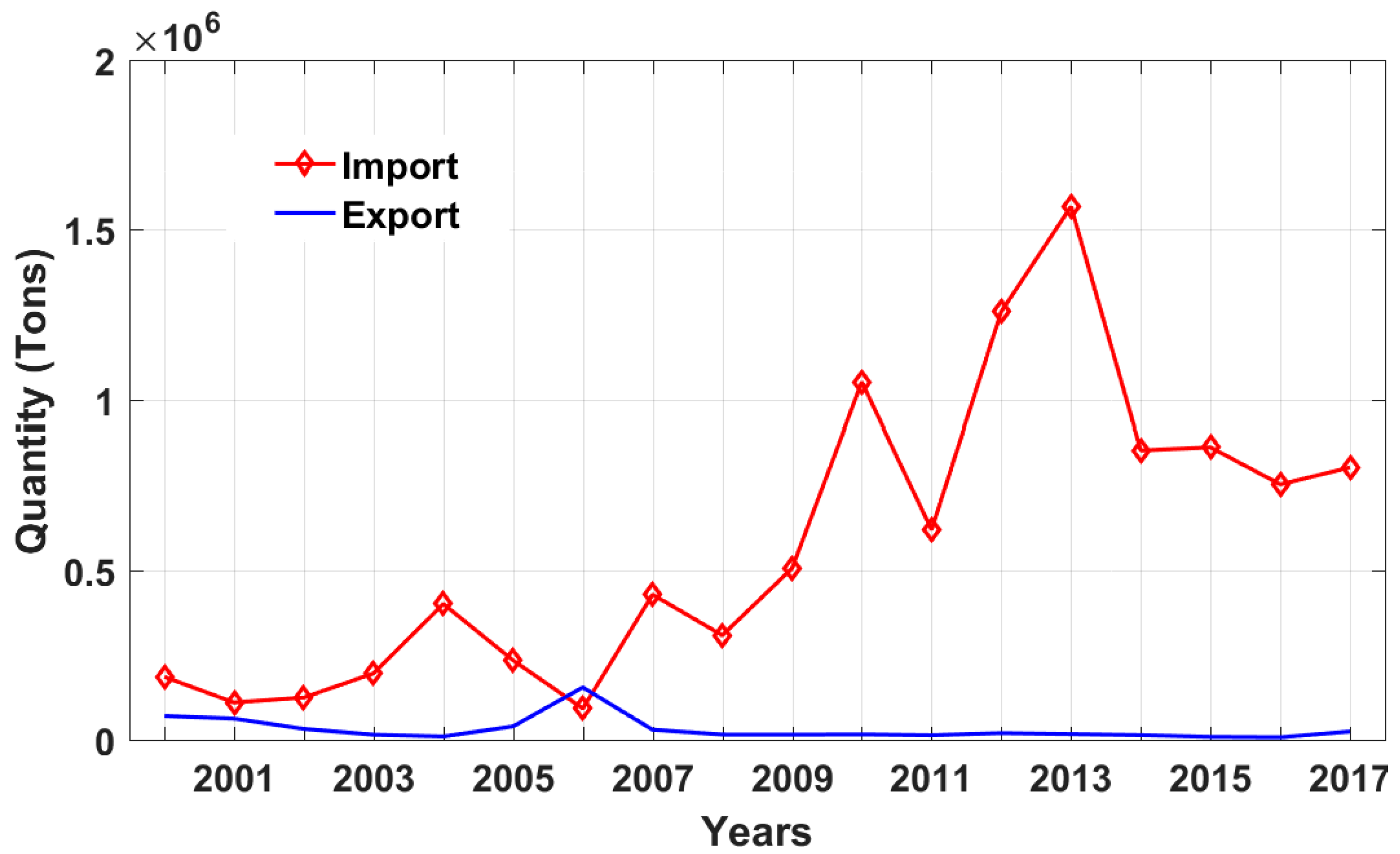
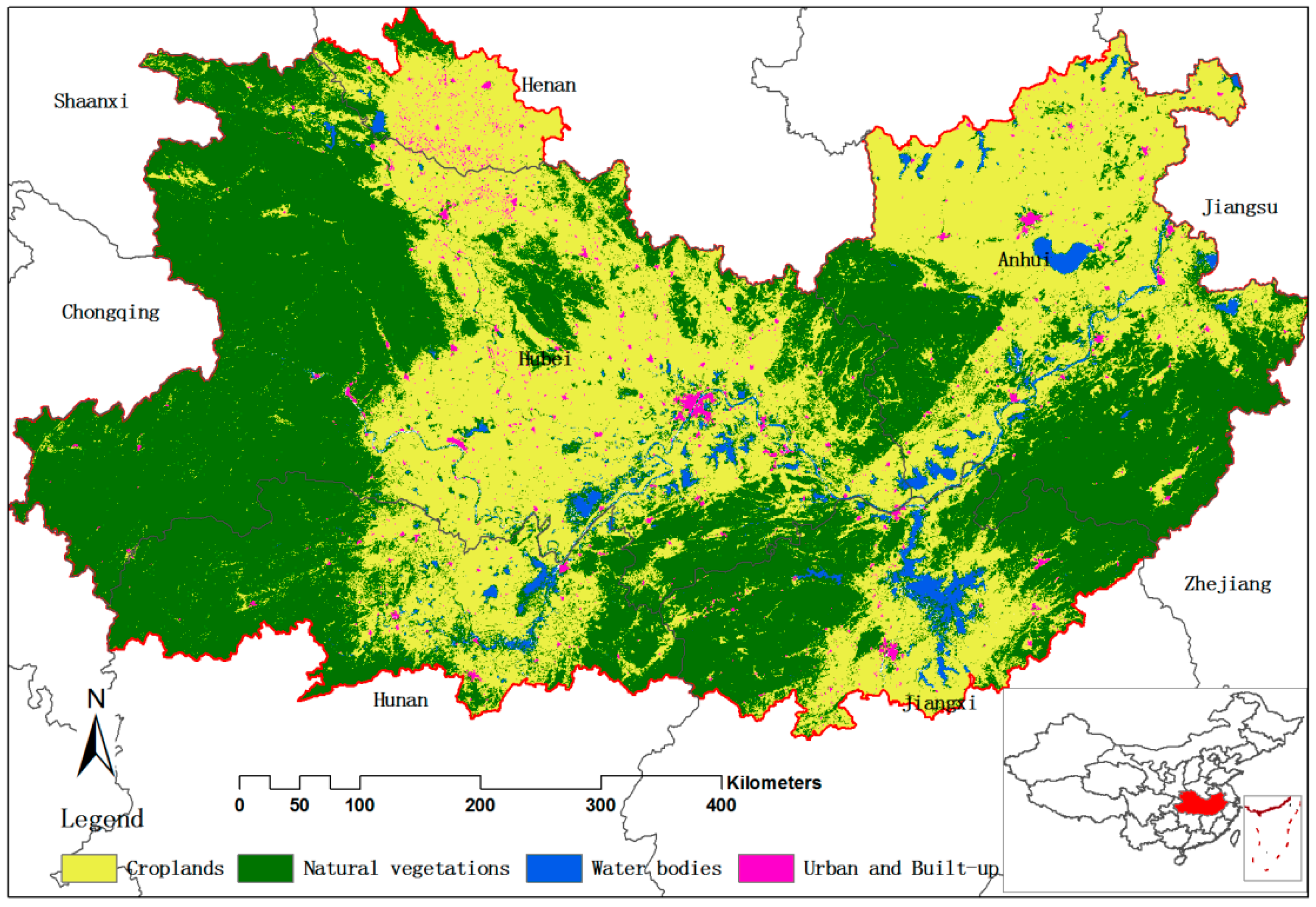


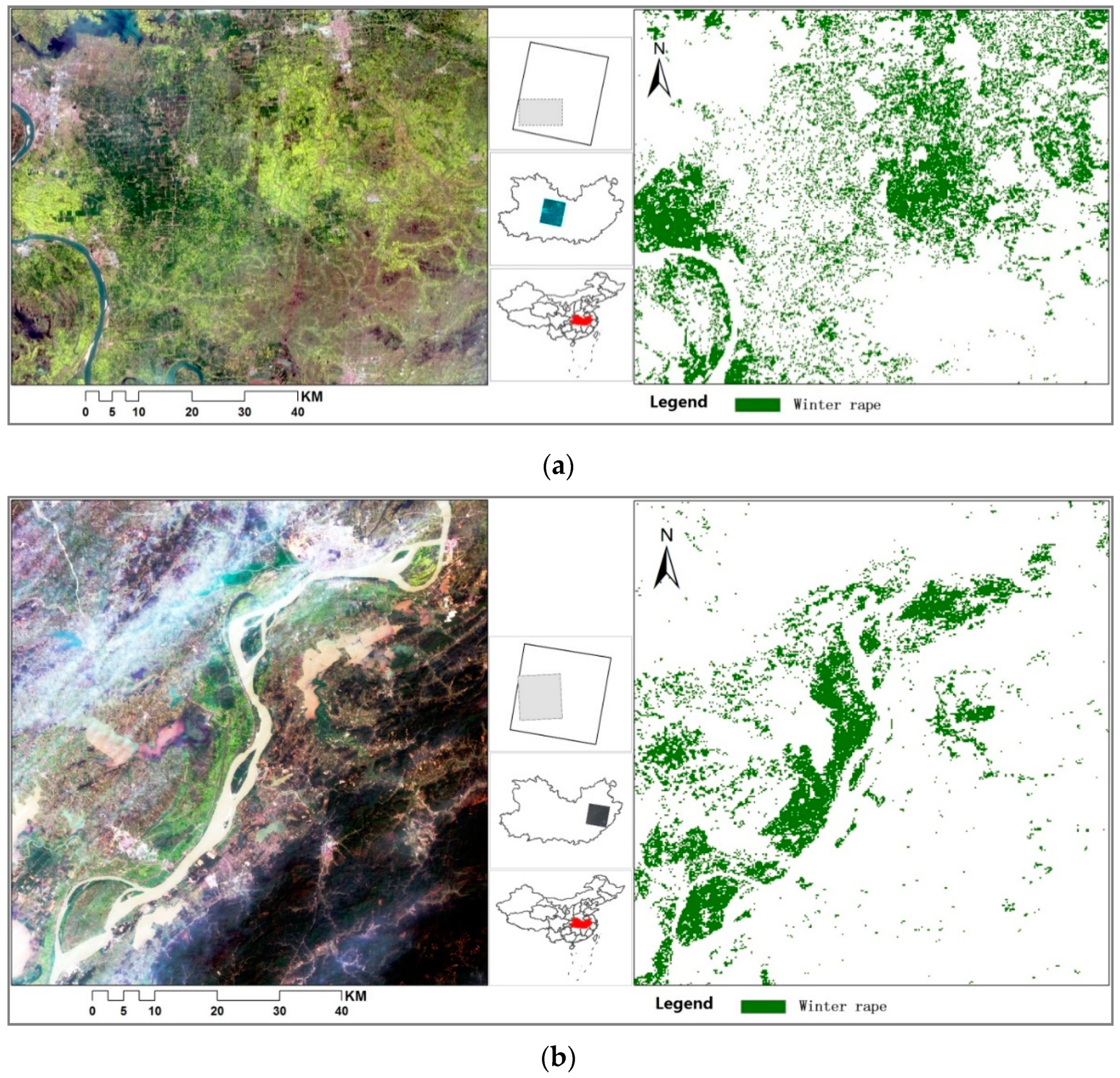
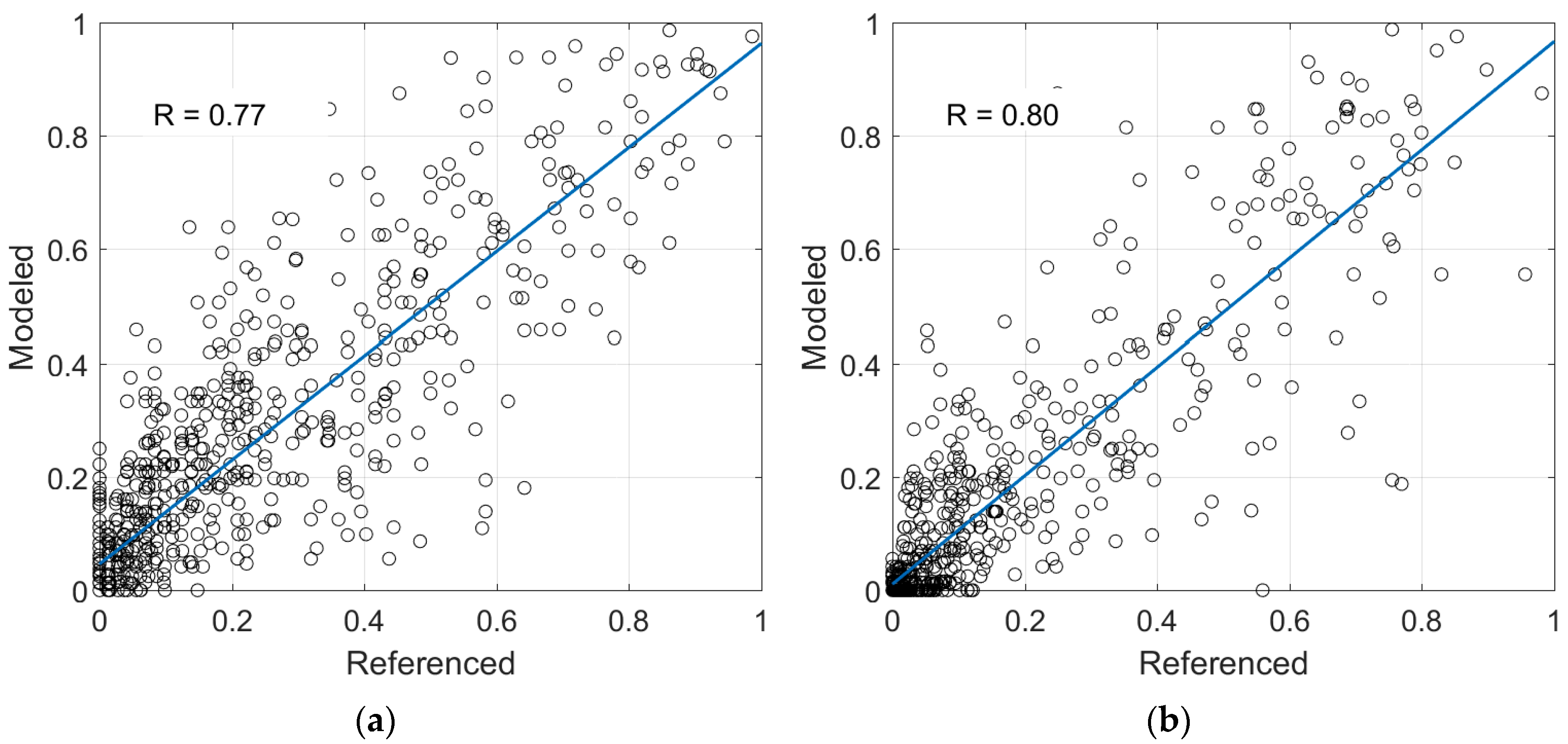
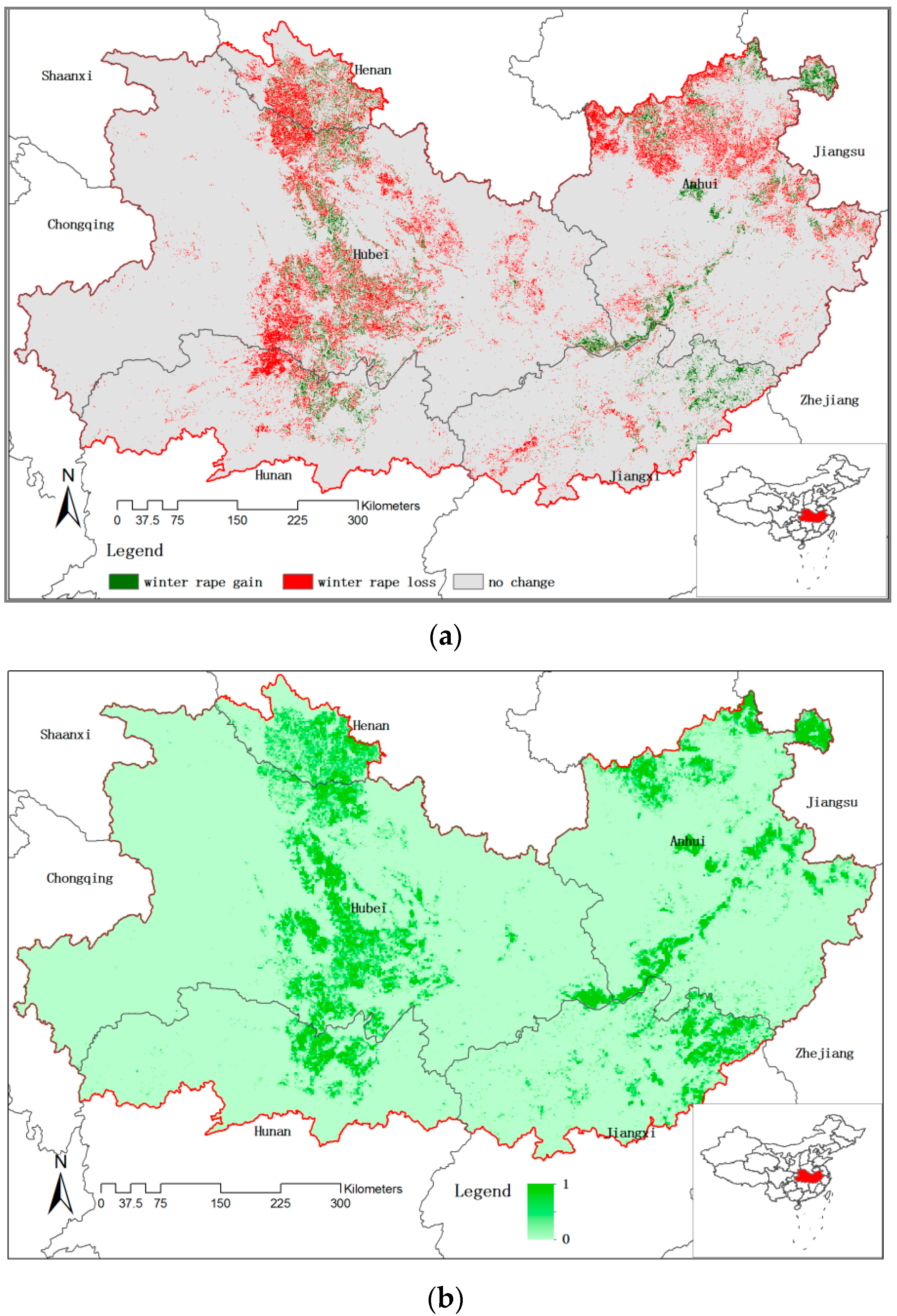
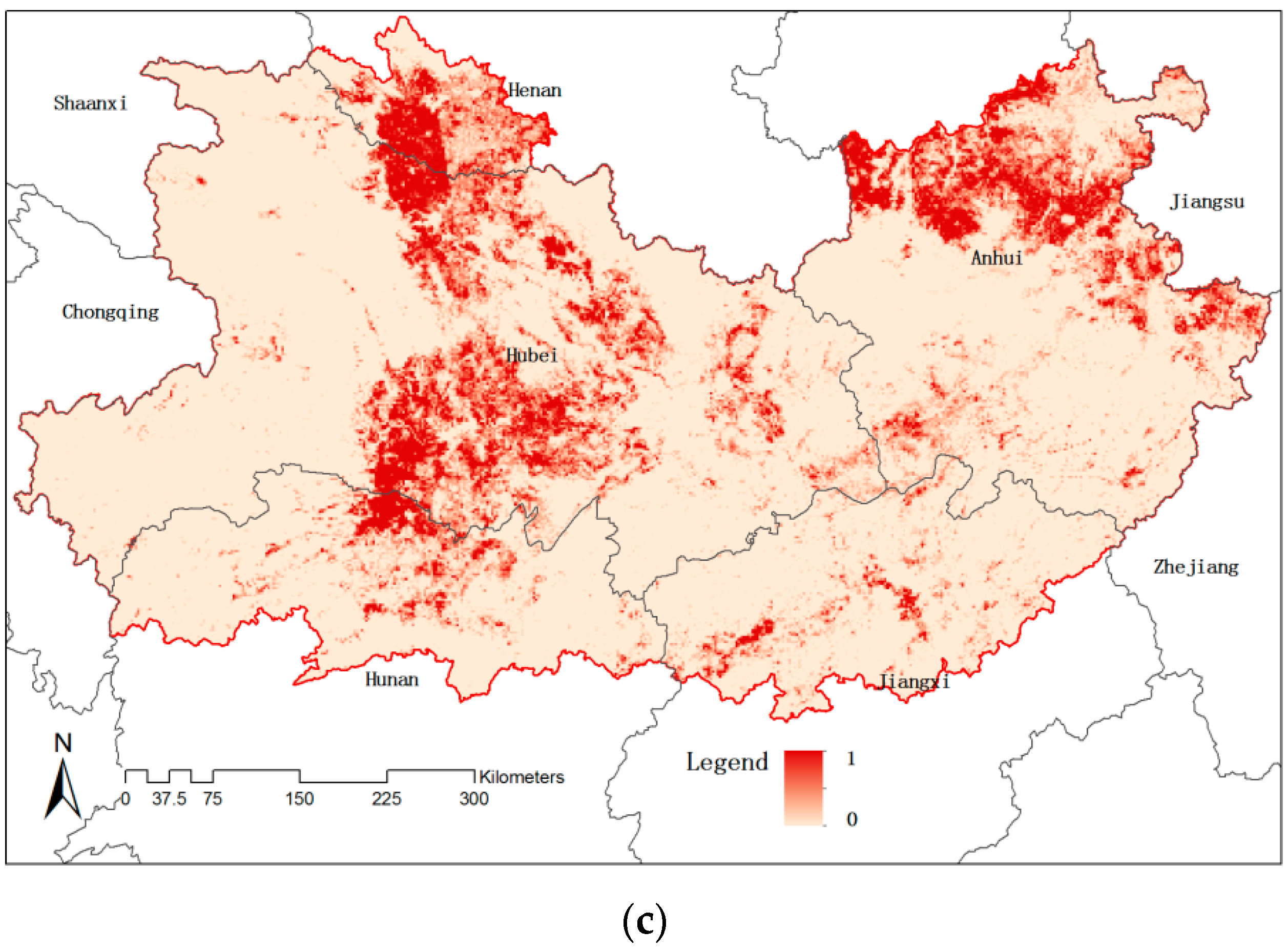

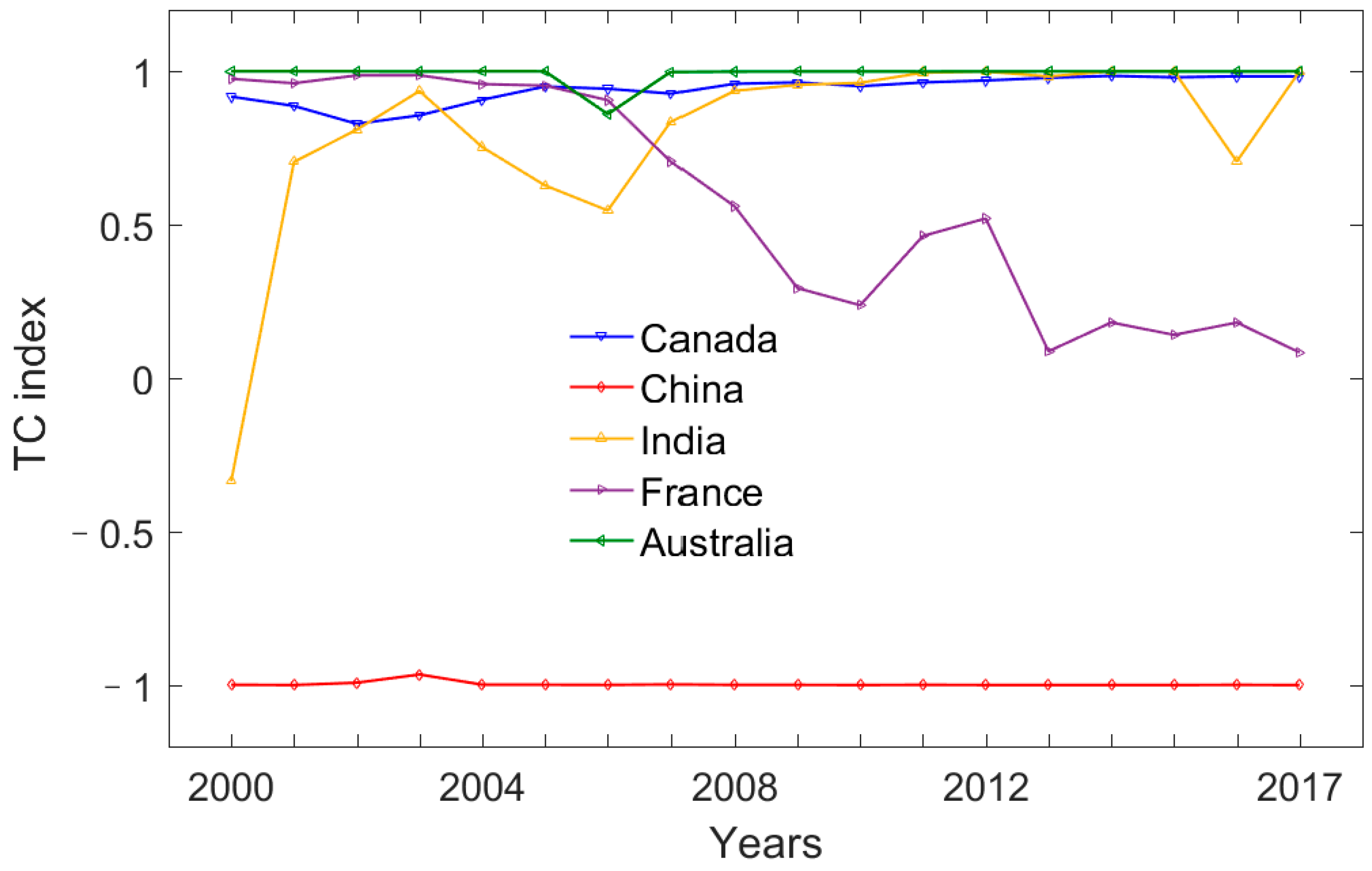
| Provinces | 2003 | 2015 | Changing Amount | Changing Rate (%) |
|---|---|---|---|---|
| Henan | 354,864.40 | 181,419.30 | −173,445.10 | −48.9 |
| Hubei | 1,615,787.00 | 839,704.60 | −776,082.40 | −48.0 |
| Hunan | 299,374.20 | 141,926.40 | −157,447.80 | −52.6 |
| Anhui | 1,064,767.00 | 526,301.20 | −538,465.80 | −50.6 |
| Jiangxi | 151,612.50 | 172,936.00 | 21,323.50 | 14.1 |
| Total | 3,486,405.10 | 1,862,287.50 | −1,624,117.60 | −46.6 |
| Indicators | Moran’s I | Z-score | p-value |
|---|---|---|---|
| 2003 | 0.53 | 10.0 | 0 |
| 2015 | 0.41 | 7.8 | 0 |
| Indicators | NP | PD | MPA | LPI | SI | AI |
|---|---|---|---|---|---|---|
| 2003 | 64,097 | 0.16 | 54 | 0.80 | 5697 | 64 |
| 2015 | 43,728 | 0.11 | 43 | 0.15 | 104,558 | 52 |
| Input | Land | Materials | Labor | Total | |||
|---|---|---|---|---|---|---|---|
| Subtotal | Seed | Pesticide | Mechanism | ||||
| China | 120.8 | 223.7 | 19.1 | 15.2 | 59.5 | 559.3 | 903.7 |
| Canada | 58.8 | 349.7 | 57.2 | 59.2 | 23.8 | 32.8 | 441.4 |
© 2020 by the authors. Licensee MDPI, Basel, Switzerland. This article is an open access article distributed under the terms and conditions of the Creative Commons Attribution (CC BY) license (http://creativecommons.org/licenses/by/4.0/).
Share and Cite
Tao, J.; Wu, W.; Liu, W.; Xu, M. Exploring the Spatio-Temporal Dynamics of Winter Rape on the Middle Reaches of Yangtze River Valley Using Time-Series MODIS Data. Sustainability 2020, 12, 466. https://doi.org/10.3390/su12020466
Tao J, Wu W, Liu W, Xu M. Exploring the Spatio-Temporal Dynamics of Winter Rape on the Middle Reaches of Yangtze River Valley Using Time-Series MODIS Data. Sustainability. 2020; 12(2):466. https://doi.org/10.3390/su12020466
Chicago/Turabian StyleTao, Jianbin, Wenbin Wu, Wenbin Liu, and Meng Xu. 2020. "Exploring the Spatio-Temporal Dynamics of Winter Rape on the Middle Reaches of Yangtze River Valley Using Time-Series MODIS Data" Sustainability 12, no. 2: 466. https://doi.org/10.3390/su12020466
APA StyleTao, J., Wu, W., Liu, W., & Xu, M. (2020). Exploring the Spatio-Temporal Dynamics of Winter Rape on the Middle Reaches of Yangtze River Valley Using Time-Series MODIS Data. Sustainability, 12(2), 466. https://doi.org/10.3390/su12020466





